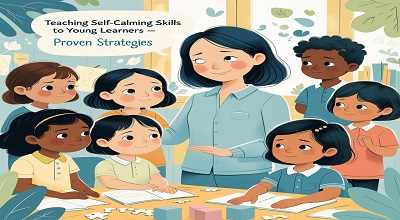Self-Calming Skills
Self-Calming Skills: In today’s fast-paced world, children face various emotional challenges that can lead to stress, anxiety, and frustration. Teaching young learners self-calming skills is essential for their emotional well-being, academic success, and social development. Educators and parents play a crucial role in helping children develop these skills early on.
This comprehensive guide explores the latest strategies for teaching self-calming techniques to young learners, backed by research and practical classroom applications.
Why Self-Calming Skills Are Important for Young Learners?
1. Emotional Regulation
Children who learn self-calming techniques can better manage their emotions, reducing outbursts and improving focus.
2. Improved Social Interactions
Self-calming skills help children navigate conflicts, share with peers, and develop empathy.
3. Enhanced Academic Performance
A calm mind is more receptive to learning, leading to better concentration and memory retention.
4. Long-Term Mental Health Benefits
Early development of self-regulation skills can prevent anxiety and stress-related issues later in life.
Latest Strategies for Teaching Self-Calming Skills
1. Mindfulness and Breathing Exercises
Mindfulness helps children stay present and aware of their emotions. Simple techniques include:
- Deep Breathing (Balloon Breathing): Inhale deeply, hold, and exhale slowly.
- Five-Finger Breathing: Trace fingers while inhaling and exhaling.
2. Sensory Tools and Fidget Toys
Providing sensory tools like stress balls, textured objects, or calming jars can help children self-regulate.
3. Guided Imagery and Visualization
Encourage children to imagine a peaceful place, guiding them through calming scenarios.
4. Yoga and Movement Breaks
Incorporating child-friendly yoga poses or short movement breaks can reduce stress.
5. Positive Affirmations and Self-Talk
Teach children to use phrases like, “I am calm” or “I can handle this” to reinforce self-regulation.
6. Emotion Identification and Labeling
Help children recognize and name their feelings using emotion charts or mood meters.
Calm-Down Corners in the Classroom
A designated space with soft lighting, cushions, and calming activities allows children to reset emotionally.
8. Storytelling and Social Stories
Books and stories about emotions can help children understand and manage their feelings.
9. Progressive Muscle Relaxation
Guide children to tense and relax different muscle groups to release stress.
10. Technology-Assisted Calming Tools
Apps like Calm or Headspace for Kids offer guided meditations and relaxation exercises.
How Teachers Can Implement These Strategies in the Classroom?
1. Model Calm Behavior
Children learn by observation—teachers should demonstrate calm responses to stress.
2. Integrate Calming Activities into Daily Routines
Start the day with a breathing exercise or include short mindfulness sessions between lessons.
3. Use Visual Cues and Reminders
Posters with breathing techniques or emotion charts help reinforce self-calming practices.
4. Encourage Peer Support
Teach students to help each other by using calming words or gestures.
5. Provide Individualized Support
Recognize that each child may need different strategies—observe and adapt accordingly.
Parental Involvement in Teaching Self-Calming Skills
Parents can reinforce self-calming techniques at home by:
- Practicing mindfulness together.
- Creating a calm-down space.
- Encouraging open conversations about emotions.
- Modeling patience and self-regulation.
Challenges and Solutions in Teaching Self-Calming Skills
1: Resistance from Children
Solution: Make activities fun and engaging, such as turning breathing exercises into games.
2: Limited Time in the Classroom
Solution: Incorporate short (1-2 minute) calming exercises between transitions.
3: Consistency Across Environments
Solution: Collaborate with parents to ensure techniques are reinforced at home.
FAQs About Teaching Self-Calming Skills to Young Learners
1. At what age should children start learning self-calming skills?
Children as young as 3 can begin with simple techniques like deep breathing and emotion labeling.
2. How long does it take for children to develop these skills?
It varies, but with consistent practice, most children show improvement within a few weeks.
3. What if a child refuses to participate in calming activities?
Try different approaches, such as incorporating their interests (e.g., superhero-themed breathing).
4. Can self-calming skills help children with ADHD?
Yes, techniques like movement breaks and sensory tools can be particularly beneficial.
5. How can teachers assess progress in self-calming skills?
Observe reductions in meltdowns, improved focus, and children using techniques independently.
Conclusion
Teaching young learners self-calming skills is a vital part of their emotional and academic growth. By incorporating the latest strategies—such as mindfulness, sensory tools, and guided imagery—educators and parents can empower children to manage stress effectively. Consistent practice, modeling, and a supportive environment are key to success.
